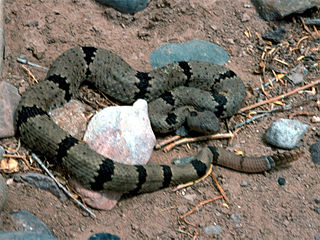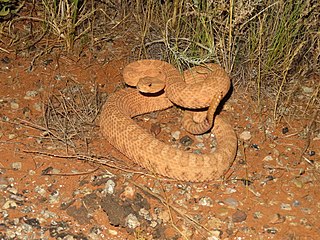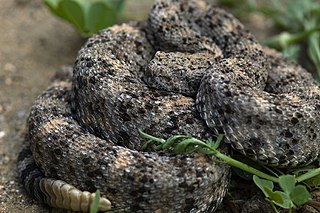
Crotalus cerastes, known as the sidewinder, horned rattlesnake or sidewinder rattlesnake, is a pit viper species belonging to the genus Crotalus, and is found in the desert regions of the Southwestern United States and northwestern Mexico. Like all other pit vipers, it is venomous. Three subspecies are currently recognized.

The eastern diamondback rattlesnake is a species of pit viper in the family Viperidae. The species is endemic to the Southeastern United States. It is one of the heaviest venomous snakes in the Americas and the largest rattlesnake. No subspecies are recognized.

Crotalus basiliscus, known as the Mexican west coast rattlesnake, Mexican green rattler, and also by other names, is a species of pit viper in the family Viperidae. The species is endemic to western Mexico. Like all other pit vipers, it is venomous. The specific name, basiliscus, is derived from the Greek word for king, βασιλισκος, and alludes to this snake's large size and potent venom. No subspecies are currently recognized.

Crotalus helleri or Crotalus oreganus helleri, known as the Southern Pacific rattlesnake, black diamond rattlesnake, and by other names, is a pit viper species or subspecies found in southwestern California and south into Baja California, Mexico, that is known for its regional variety of dangerous venom types. It is sometimes considered a subspecies of Crotalus oreganus.

Crotalus willardi is a venomous pit viper species found in the southwestern United States and Mexico. This snake is found mainly in the "sky island" region. The IUCN reports this snake's conservation status as being of Least Concern. It is the official state reptile of Arizona.

Crotalus ruber is a venomous pit viper species found in southwestern California in the United States and Baja California in Mexico. Three subspecies are currently recognized, including the nominate subspecies described here.

The western diamondback rattlesnake or Texas diamond-back is a rattlesnake species and member of the viper family, found in the southwestern United States and Mexico. Like all other rattlesnakes and all other vipers, it is venomous. It is likely responsible for the majority of snakebite fatalities in northern Mexico and the greatest number of snakebites in the U.S. No subspecies are currently recognized.

Crotalus viridis is a venomous pit viper species native to the western United States, southwestern Canada, and northern Mexico. Currently, two subspecies are recognized, including the prairie rattlesnake, the nominate subspecies, and the Hopi rattlesnake.

Crotalus viridis nuntius is a venomous pit viper subspecies native primarily to the desert plateau of the northeastern portion of the American state of Arizona, but also ranges into northwestern New Mexico. Named for the Native American Hopi tribe, which inhabits the region, its range overlaps that of the nominate subspecies and some interbreeding is believed to occur. The taxonomy of the C. viridis group is a matter of debate, many considering the various subspecies to be nothing more than locality variations.

Crotalus lepidus klauberi is a venomous pitviper subspecies endemic to the southwestern United States and adjacent northern Mexico.

Sistrurus tergeminus, also known as the western massasauga, is a rattlesnake found in the southwestern plains of the United States and northern Mexico. Like all rattlesnakes, it is a pit viper and is venomous.

Crotalus oreganus abyssus is a venomous pit viper subspecies found only in the U.S. states of Arizona and Utah.

Crotalus oreganus, commonly known as the (northern) Pacific rattlesnake, is a venomous pit viper species found in western North America from the Baja California Peninsula to the southern interior of British Columbia.

Crotalus atrox tortugensis is a venomous pit viper subspecies found only on Tortuga Island in the Gulf of California.

The tiger rattlesnake is a highly venomous pit viper species found in the southwestern United States and northwestern Mexico. No subspecies are currently recognized. The specific name tigris,, refers to the many narrow dorsal crossbands, which create a pattern of vertical stripes when viewed from the side.

The Great Basin rattlesnake is a venomous pit viper species found in the Great Basin region of the United States.

Crotalus pricei is a species of venomous snake, a pit viper in the family Viperidae. The species is endemic to the southwestern United States and northern Mexico. Two subspecies are recognized.

Crotalus cerastes cercobombus, commonly known as the Sonoran Desert sidewinder or Sonoran sidewinder, is a pitviper subspecies found in the eastern part of the Sonoran Desert in the southwestern United States and northwestern Mexico. Like all pitvipers, it is venomous. The subspecific epithet means buzzertail.

Crotalus concolor, commonly known as the midget faded rattlesnake, faded rattlesnake and yellow rattlesnake, is a pit viper species found in the western United States. It is a small rattlesnake known for its faded color pattern. Like all other pit vipers, it is venomous.

Crotalus pyrrhus is a venomous pitviper species found in the southwestern United States and northwestern Mexico. A medium-sized snake, it is found mostly in rocky country, active at night and feeding on small mammals. The coloration is variable and depends on the color of the rocks and soil of the habitat.




















